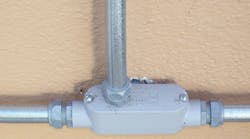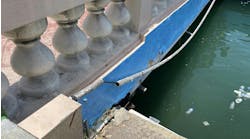Answer:
I am sure many workers have installed this equipment in the same manner and said, "As long as it was approved by the electrical inspector, it is okay!" I say that's a lot of guff. A seasoned, licensed, and properly trained person should agree with me on this.
As per 300.15, “Fittings and connectors shall be used only with the specific wiring methods for which they are designed and listed.” In addition, the requirements of 110.2 state “The conductors and equipment required or permitted by this Code shall be acceptable only if approved. FPN: See 90.7, Examination of Equipment for Safety, and 110.3, Examination, Identification, Installation, and Use of Equipment. See definitions of Approved, Identified, Labeled, and Listed.” And let’s not forget about the requirements of 110.3(B), which state “Listed or labeled equipment shall be installed and used in accordance with any instructions included in the listing or labeling.”
Just because you may have made up an installation like this in the past — and it was accepted — doesn’t mean it was ever legal.



